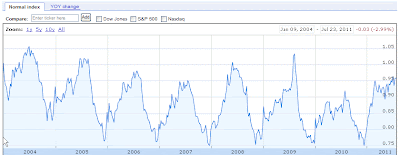I borrowed the word from Lee Adler.
As you can see, cumulative net money flow is still positive and well above the SPX. Lee’s chart is “based upon the theory that as cash moves between money market funds and the banking system, there's a relationship between that movement and the movement of stock prices. As you can see, it has correlated well with stock prices over the past couple of years.”
In his latest email newsletter Lee writes as follows:
“It seemed that virtually every market observer expected that event to have a bearish impact. My expectation was that it would not be felt until mid July due to technical factors having to do with the Treasury supply settlement schedule. But over the past month, the indicator shown above began to surge, boosting support for the market just as the Fed was ready to step away.
Hysterical media pundits have been loudly proclaiming that the sky is falling as a result of the approaching US Debtmageddon. The markets, however, are revealing them as the know nothing clowns that they are. In fact, the opposite of their dire predictions has been occurring, with both stocks and bonds remaining resilient. The Treasury market is even rallying today after the uber depressing N'Obama Boner show last night. You gotta laugh.
The chart above makes clear the reason for this market resiliency. Money has been flooding into the US banking system over the past month. The source is apparently capital flight out of the Eurozone. While I don't track the data at the source of those flows, we know from anecdotal reports that there's been capital flight out of parts of Europe. Other US banking system indicators suggest that this is the source of the surge of cash into US bank accounts. The cash account balances of US based foreign banks have been surging in recent weeks. So have their trading accounts. Deposits in domestically chartered banks have also surged, but their trading accounts have not. It would appear that that the resiliency in the US equity market has been driven by foreign private buying. The Fed's data shows that foreign central banks have not been a factor. This is coming from the private sector”
For some reason private capital all over the world considers US to be safer than Europe and I suppose they know more than I do. But this is one reason I have not gone short yet.
But I am not blindly long and I may switch sides all of a sudden inter-day and shout “let’s get out”. Follow me on Twitter to get my latest calls.
Once again, make no mistake; these are all part of forming the top. But we do not want to go short when the market is still going up. That is not smart. I talked about 27th July before and we are almost there. For me the most crucial dates are between 27th of July to 5th of August. And I willl be watching the market activities closely to see if my calls are still valid. You see, I do not mind bring wrong, but I do not want to be wrong for a long time.
If you like what you are reading, please forward it to your friends. http://bbfinance.blogspot.com/


